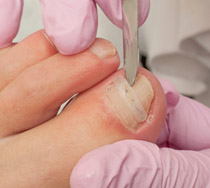Onychomycosis, predisposing factors, characteristics and associated dermatosis
Keywords:
ONYCHOMYCOSIS, SKIN/injuries, SKIN DISEASES, SKIN CARE, MYCOSES, RISK FACTORS.Abstract
Introduction: fungal infections in skin, hair and nails are common worldwide, in this context, onychomycosis is the most prevalent disease where the province is no exception.
Objective: to describe the risk factors, characteristics and associated dermatosis in patients older than 18 years old with onychomycosis in a health area.
Methods: observational, descriptive and cross-sectional study conducted at Raúl Sánchez Rodríguez University Polyclinic, Dermatology Clinic during the period 2017-2018.
Results: female sex predominated (55.1%) and the age group between 40 and 59 years (43.8 %), the predominant risk factor was the use of occlusive footwear (84.9 %). Localization in feet (unilateral) (45.9 %), lateral plus distal superficial clinical type (33 %), as well as onycholysis plus incurvation (54.6%) predominated as the main ungueal alteration. The main ungueal modification belonged to the longitudinal lines (70.8 %), in terms of consistency a thickening of the nails (68.1 %), with leukonychia (47 %) and melanonychia (36.8 %), which were the main colors detected. Tinea pedis (55 %) and crural (10, 8 %) were the most frequent associated dermatosis.
Conclusions: it is important to distinguish the clinical epidemiological behavior of onychomycosis in order to be able to act and modify the risk factors and influence of the associated dermatosis and in one way or another to reduce the incidence of onychomycosis.
Downloads
References
1. Martínez Vilar C, Mosquera Fernández A, Monteagudo Sánchez B. Estudio observacional y descriptivo de prevalencia de onicomicosis en una población que acude a una consulta de dermatología del Área Sanitaria de Ferrol. Revista Internacional de Ciencias Podológicas [Internet]. 2015 [citado 25/12/2018], 9(2): 89-98. Disponible en: https://core.ac.uk/download/pdf/38810276.pdf
2. Mejía-Arango MA, Santa-Vélez C, Cadavid-Sierra M, Vélez LM, Colmenares LM, Restrepo-Jaramillo BN, Cardona-Castro N. Estudio etiológico y epidemiológico de las micosis cutáneas en un laboratorio de referencia – Antioquia – Colombia. Rev CES Med [Internet]. 2013 [citado 25/12/2018]: 27(1): 7-19. Disponible en: http://bdigital.ces.edu.co:8080/repositorio/bitstream/10946/3351/1/1.pdf
3. Ballesté R, Mousqués N, Gezuele E. Onicomicosis. Revisión del tema. Rev Med Uruguay [Internet] 2013 [citado 25/12/2018]; 19: 93-106. Disponible en: http://www.rmu.org.uy/revista/2013v2/art3.pdf
4. Velásquez Cano O, Duque Restretpo C, Correa Gómez E. Frecuencia de onicomicosis en un grupo de personas de la ciudad de Medellín. Revista Sinergia [Internet]. 2018 [citado 21/12/2018]; 1(1): 36-53. Disponible en: http://sinergia.colmayor.edu.co/ojs/index.php/Revistasinergia/article/view/13
5. Monteagudo-Sánchez B, Mosquera-Fernández A, Santalla-Borreiros F. El valor diagnóstico de la dermatoscopia en la onicomicosis blanca superficial. Enferm Dermatol [Internet]. 2018 [citado 25/12/2018]; 12(33): 52-53. Disponible en: https://dialnet.unirioja.es/descarga/articulo/6549136.pdf
6. Cobos Lladó D, Fierro Arias L, Arellano Mendoza I, Bonifaz A. La onicomicosis y su influencia en la calidad de vida. Derma Cosmética y Quirúrgica [Internet]. 2016 [citado 25/12/2018]; 14 (4): 318-327. Disponible en: http://www.medigraphic.com/pdfs/cosmetica/dcm-2016/dcm164h.pdf
7. Sabogal M, Jiménez H, Morales C, Alvarado Z, Colmenares C. Micosis en los pies: descripción clínico-epidemiológica en un centro de referencia de Bogotá, Colombia. Infectio [Internet] 2019 [citado 25/12/2018]; 23(1): 39-44. Disponible en: http://www.revistainfectio.org/index.php/infectio/article/view/754/792
8. Casanova-Claure E, Navarrete-Mejí P. Perfil epidemiológico y características clínicas de la onicomicosis en población militar. Med Cutan Iber Lat Am [Internet]. 2017 [citado 25/12/2018]; 45(3): 191-194. Disponible en: https://dialnet.unirioja.es/servlet/articulo?codigo=6583122&orden=0&info=link
9. Santos de Carvalho Ribeiro C, Zaitz C, de Souza Framil VM, Santos de Carvalho Ottoboni T, Santos de Carvalho Tonoli M, Pinheiro Ribeiro R. Descriptive study of onychomycosis in a hospital in São Paulo. Braz J Microbiol [Internet]. 2015 Jun [citado 25/12/2018]; 46(2): 485–492. DOI: 10.1590/S1517-838246220130541
10. Jenna N. Queller1 and Neal Bhatia. The Dermatologist’s Approach to Onychomycosis. J Fungi (Basel) [Internet]. 2015 Sep [citado 25/12/2018]; 1(2): 173–184. DOI: 10.3390/jof1020173
11. Jara H C, de Lezcano L B, Knopfelmacher O. Dermatosis de consulta más frecuente en pacientes geríatricos. In Anales de la Facultad de Ciencias Médicas [Internet]. 2015 [citado 25/12/2018]; 38(3): 57-60. Disponible en: http://revistascientificas.una.py/index.php/RP/article/download/529/438
12. Marvlyn Eba,1 Anna Longdoh Njunda,1 Rene Njikam Mouliom,2 Emmanuel Tebit Kwenti,corresponding author1,4 Anold Nsoh Fuh,1 Gordon Takop Nchanji,3 and Julius Atashili. Onychomycosis in diabetic patients in Fako Division of Cameroon: prevalence, causative agents, associated factors and antifungal sensitivity patterns. BMC Res Notes [Internet]. 2016 [citado 25/12/2018]; 9: 494. DOI: 10.1186/s13104-016-2302-1
13. del Pilar Villanueva J, Juliana Díaz C, Luna J. Perfil epidemiológico de la onicomicosis en un servicio de dermatología de un hospital de tercer nivel en Cali, Colombia. Rev Asoc Colomb Dermatol [Internet]. 2013 [citado 25/12/2018]; 21(1): 31-37. Disponible en: https://revistasocolderma.org/sites/default/files/perfil_epidemiologico_de_la_onicomicosis_en_un_servicio_de_dermatologia_de_un_hospital_de_tercer_nivel_en_cali_colombia.pdf

Downloads
Published
How to Cite
Issue
Section
License
Authors who have publications with this journal agree to the following terms: Authors will retain their copyrights and grant the journal the right of first publication of their work, which will be publication of their work, which will be simultaneously subject to the Creative Commons Attribution License (CC-BY-NC 4.0) that allows third parties to share the work as long as its author and first publication in this journal are indicated.
Authors may adopt other non-exclusive license agreements for distribution of the published version of the work (e.g.: deposit it in an institutional telematic archive or publish it in a volume). Likewise, and according to the recommendations of the Medical Sciences Editorial (ECIMED), authors must declare in each article their contribution according to the CRediT taxonomy (contributor roles). This taxonomy includes 14 roles, which can be used to represent the tasks typically performed by contributors in scientific academic production. It should be consulted in monograph) whenever initial publication in this journal is indicated. Authors are allowed and encouraged to disseminate their work through the Internet (e.g., in institutional telematic archives or on their web page) before and during the submission process, which may produce interesting exchanges and increase citations of the published work. (See The effect of open access). https://casrai.org/credit/


